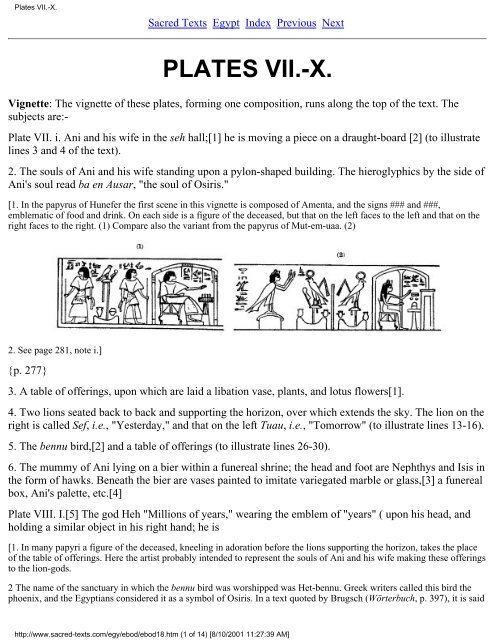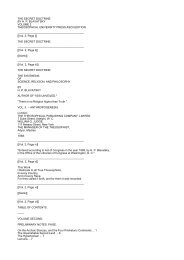You also want an ePaper? Increase the reach of your titles
YUMPU automatically turns print PDFs into web optimized ePapers that Google loves.
Plates VII.-X.<br />
Sacred Texts Egypt Index Previous Next<br />
PLATES VII.-X.<br />
Vignette: The vignette <strong>of</strong> <strong>the</strong>se plates, forming one composition, runs along <strong>the</strong> top <strong>of</strong> <strong>the</strong> text. The<br />
subjects are:-<br />
Plate VII. i. Ani and his wife in <strong>the</strong> seh hall;[1] he is moving a piece on a draught-board [2] (to illustrate<br />
lines 3 and 4 <strong>of</strong> <strong>the</strong> text).<br />
2. The souls <strong>of</strong> Ani and his wife standing upon a pylon-shaped building. The hieroglyphics by <strong>the</strong> side <strong>of</strong><br />
Ani's soul read ba en Ausar, "<strong>the</strong> soul <strong>of</strong> Osiris."<br />
[1. In <strong>the</strong> papyrus <strong>of</strong> Hunefer <strong>the</strong> first scene in this vignette is composed <strong>of</strong> Amenta, and <strong>the</strong> signs ### and ###,<br />
emblematic <strong>of</strong> food and drink. On each side is a figure <strong>of</strong> <strong>the</strong> deceased, but that on <strong>the</strong> left faces to <strong>the</strong> left and that on <strong>the</strong><br />
right faces to <strong>the</strong> right. (1) Compare also <strong>the</strong> variant from <strong>the</strong> papyrus <strong>of</strong> Mut-em-uaa. (2)<br />
2. See page 281, note i.]<br />
{p. 277}<br />
3. A table <strong>of</strong> <strong>of</strong>ferings, upon which are laid a libation vase, plants, and lotus flowers[1].<br />
4. Two lions seated back to back and supporting <strong>the</strong> horizon, over which extends <strong>the</strong> sky. The lion on <strong>the</strong><br />
right is called Sef, i.e., "Yesterday," and that on <strong>the</strong> left Tuau, i.e., "Tomorrow" (to illustrate lines 13-16).<br />
5. The bennu bird,[2] and a table <strong>of</strong> <strong>of</strong>ferings (to illustrate lines 26-30).<br />
6. The mummy <strong>of</strong> Ani lying on a bier within a funereal shrine; <strong>the</strong> head and foot are Nephthys and Isis in<br />
<strong>the</strong> form <strong>of</strong> hawks. Beneath <strong>the</strong> bier are vases painted to imitate variegated marble or glass,[3] a funereal<br />
box, Ani's palette, etc.[4]<br />
Plate VIII. I.[5] The god Heh "Millions <strong>of</strong> years," wearing <strong>the</strong> emblem <strong>of</strong> "years" ( upon his head, and<br />
holding a similar object in his right hand; he is<br />
[1. In many papyri a figure <strong>of</strong> <strong>the</strong> deceased, kneeling in adoration before <strong>the</strong> lions supporting <strong>the</strong> horizon, takes <strong>the</strong> place<br />
<strong>of</strong> <strong>the</strong> table <strong>of</strong> <strong>of</strong>ferings. Here <strong>the</strong> artist probably intended to represent <strong>the</strong> souls <strong>of</strong> Ani and his wife making <strong>the</strong>se <strong>of</strong>ferings<br />
to <strong>the</strong> lion-gods.<br />
2 The name <strong>of</strong> <strong>the</strong> sanctuary in which <strong>the</strong> bennu bird was worshipped was Het-bennu. Greek writers called this bird <strong>the</strong><br />
phoenix, and <strong>the</strong> Egyptians considered it as a symbol <strong>of</strong> Osiris. In a text quoted by Brugsch (Wörterbuch, p. 397), it is said<br />
http://www.sacred-texts.com/egy/ebod/ebod18.htm (1 <strong>of</strong> 14) [8/10/2001 11:27:39 AM]

















